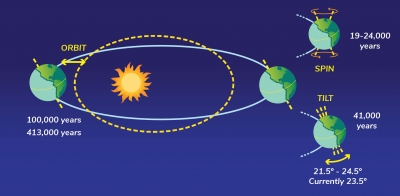
|
Yes, Earth spins around a line between the poles called its axis. The axis is tilted over at 23.5° in relation to the Sun. Earth rotates once every 23 hours, 56 minutes and 4.09 seconds. The Sun thus appears to come back to the same place in the sky once every 24 hours. |
Earth’s spin, tilt, and orbit affect the amount of solar energy received by any particular region of the globe, depending on latitude, time of day, and time of year. Small changes in the angle of Earth’s tilt and the shape of its orbit around the Sun cause changes in climate over a span of 10,000 to 100,000 years, and are not causing climate change today.
Daily changes in light and temperature are caused by the rotation of the Earth, and seasonal changes are caused by the tilt of the Earth. As the Earth orbits the Sun, the Earth is pulled by the gravitational forces of the Sun, Moon, and large planets in the solar system, primarily Jupiter and Saturn. Over long periods of time, the gravitational pull of other members of our solar system slowly change Earth’s spin, tilt, and orbit. Over approximately 100,000 – 400,000 years, gravitational forces slowly change Earth’s orbit between more circular and elliptical shapes. Over 19,000 – 24,000 years, the direction of Earth’s tilt shifts (spins). Additionally, how much Earth’s axis is tilted towards or away from the Sun changes through time, over approximately 41,000 year cycles. Small changes in Earth’s spin, tilt, and orbit over these long periods of time can change the amount of sunlight received (and therefore absorbed and re-radiated) by different parts of the Earth. Over 10s to 100s of thousands of years, these small changes in the position of the Earth in relationship to the Sun can change the amount of solar radiation, also known as insolation, received by different parts of the Earth. In turn, changes in insolation over these long periods of time can change regional climates and the length and intensity of the seasons. The Earth’s spin, tilt, and orbit continue to change today, but do not explain the current rapid climate change.
credit: UNDERSTANDING GLOBAL CHANGE
Picture credit: Google




